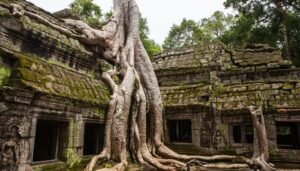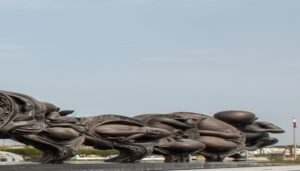Most travellers have a particular passion for something, whether it’s scenery, street-food, art or music. Some people will travel across the world to see a particular steam locomotive or rock-band. And architecture? There are folk who walk past a particular building without noticing it, while others instantly recognize whether a stone column is Doric, Corinthian or Ionic. Others will hotly contend that nothing since the Belle Époque era is worthy of attention. Serving more than 160 destinations around the world from their Doha hub, Hamad International Airport, Qatar Airways’ crew get to go lots of places, often. They share some views about their favourite architecture and landmarks:
Sagrada Família church, Barcelona: Construction began on Antoni Gaudi’s ambitious Gothic masterwork in 1882 and is tentatively scheduled for completion by 2026, or perhaps as late as 2040, when the tallest of its 18 spires will reach 170m into the Spanish sky. The vast (it can accommodate 9 000 people) building is a staggering undertaking, including intricate facades and soaring granite towers that seem organic, even voluptuous.
- Factoid: Rock initially used to build the church was from the nearby Montjuïc mountain, which has been quarried there for thousands of years and favoured its range of colours and was widely used during the Roman Empire. But in around 1954 it became apparent that the builders would run out of the stone, and that which remains in the mountain often has cracks. Similar, suitable rock was eventually found at a quarry in Chorley, Lancashire, and has been used since.
- Factoid: Despite much local opposition, a tunnel for high-speed trains was bored under the church some years ago. The structure seems unaffected by the construction or the daily passage of the rolling-stock.
Ankor Wat, Siĕmréab, Cambodia: A sprawling complex of more than a thousand temples and buildings, it’s one of the world’s cultural wonders and the world’s biggest religious structure, covering 400 acres. It was built as the earthly representation of Mount Meru, the Mount Olympus of the Hindu faith, and the abode of ancient gods. It was later converted to a Buddhist shrine. Although it’s been in almost continual use since it was built, some of the 30 000 stone carvings of asparas (heavenly nymphs) – each unique – were damaged by weathering, bat urine and droppings, and by an ill-advised effort to clean them with chemicals. Restoration is ongoing and successful.
- Factoid: So admired is the temple complex that it appears on the Cambodian flag and the government built an airport – the country’s biggest – chiefly to fly tourists in.

Sidra Medical and Research Center, Doha: A focal point for Qatar’s medical education and biomedical research, as well as women’s, natal and paediatric medicine, the exterior of the building comprises steel, glass and white ceramic tile, with three towering sails to evoke Qatar’s seafaring heritage. In a city renowned for its public art, Sidra Medicine has a series of 14 giant bronze sculptures by Damien Hirst called The Miraculous Journey, portraying the development of a baby in the uterus from conception to birth. Inside, patients’ rooms overlook three tranquil “healing gardens” with lush greenery, water-features and calming hues.
- Factoid: The building was designed by Cesar Pelli, whose CV includes the World Financial Centrein New York, the Petronas Towers in Malaysia and the International Finance Centre in Hong Kong.

111 West 57th Street, Central Park, New York: The world’s skinniest skyscraper and the second-tallest residential building in the Western Hemisphere, it lances 435m heavenwards above the city’s Billionaire’s Row. The architects incorporated a New York landmark, the Steinway Tower, synonymous with the city’s pre-war Golden Age, and in collaboration with the Landmarks Preservation Commission of New York. The tower’s interiors echo this nod to the past, with graceful, retro designs combined with extra-tall windows that capitalise on the dizzying, unsurpassed views of the park and the city. Attaining the height and narrowness – a 24:1 ratio – required specially hardened steel and concrete, but results in spacious, airy interiors and double-volume areas.
Factoid: If you enjoy your visit so much that you’d like to own one of the penthouses, a three-bedroomed penthouse will set you back between USD9m and USD24m.

Taj Mahal, Uttar Pradesh, India: Instantly recognisable? Yes. Worth a visit? Absolutely. Translated as “Crown of the Palace”, the white-marble mausoleum is the centrepiece of a 42-acre estate and is thought to have required round 20 000 artisans and craftspeople to construct and decorate. The result is a symphony of the finest examples of Mughal architecture and Indo-Islamic design. Apart from the exquisitely intricate Arabic calligraphy and symbolic imagery carved or painted, and lapidaries of precious and semiprecious stones throughout, the gardens and reflective pool make for an unforgettable visit.
- Factoid: The Taj Mahal was commissioned by the fifth Mughal Emperor, Shah Jahan, as the tomb of his beloved wife, Mumtaz Mahal, and is the couple’s final resting-place.




